Chinese Journal of Tissue Engineering Research ›› 2025, Vol. 29 ›› Issue (23): 4965-4974.doi: 10.12307/2025.097
Previous Articles Next Articles
Effects of cannabidiol on hepatic stellate cell activation and hepatic fibrosis induced by transforming growth factor beta1
Wang Lian1, 2, Xie Na2, Zhao Peiling1, 2, Chen Hao1, 2, Li Duyou1, 2, Wang Yuping1, 2
- 1Clinical Laboratory Center, Affiliated Hospital of Guizhou Medical University, Guiyang 550003, Guizhou Province, China; 2Department of Clinical Microbiology and Immunology, School of Clinical Laboratory Science, Guizhou Medical University, Guiyang 550004, Guizhou Province, China
-
Received:2024-03-06Accepted:2024-05-22Online:2025-08-18Published:2024-09-30 -
Contact:Wang Yuping, Professor, Doctoral supervisor, Clinical Laboratory Center, Affiliated Hospital of Guizhou Medical University, Guiyang 550003, Guizhou Province, China; Department of Clinical Microbiology and Immunology, School of Clinical Laboratory Science, Guizhou Medical University, Guiyang 550004, Guizhou Province, China -
About author:Wang Lian, Master candidate, Clinical Laboratory Center, Affiliated Hospital of Guizhou Medical University, Guiyang 550003, Guizhou Province, China; Department of Clinical Microbiology and Immunology, School of Clinical Laboratory Science, Guizhou Medical University, Guiyang 550004, Guizhou Province, China -
Supported by:National Natural Science Foundation of China, No. 81860118 (to WYP); Guizhou Provincial Health Commission Science and Technology Foundation, No. gzwkj2021-119 (to WYP)
CLC Number:
Cite this article
Wang Lian, Xie Na, Zhao Peiling, Chen Hao, Li Duyou, Wang Yuping. Effects of cannabidiol on hepatic stellate cell activation and hepatic fibrosis induced by transforming growth factor beta1[J]. Chinese Journal of Tissue Engineering Research, 2025, 29(23): 4965-4974.
share this article
Add to citation manager EndNote|Reference Manager|ProCite|BibTeX|RefWorks
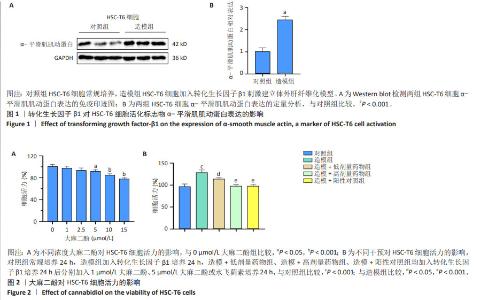
2.1 体外实验结果 2.1.1 转化生长因子β1对HSC-T6细胞活化标志物α-平滑肌肌动蛋白表达的影响 α-平滑肌肌动蛋白是HSC-T6细胞活化的标志物,其表达水平升高提示HSC-T6细胞受到刺激发生了活化,活化后会向肌成纤维细胞转变。与对照组比较,造模组HSC-T6细胞活化分子标志物α-平滑肌肌动蛋白表达明显升高(P < 0.001),见图1,提示在转化生长因子β1诱导下,HSC-T6细胞发生活化,表达大量的α平滑肌肌动蛋白。 2.1.2 大麻二酚对HSC-T6细胞活力的影响 通过CCK-8实验筛选大麻二酚作用浓度,结果显示:随着培养基中大麻二酚浓度的升高,HSC-T6细胞活力逐渐下降,见图2A。为避免高浓度大麻二酚对HSC-T6细胞产生毒性,因此选择低剂量 1 μmol/L和高剂量5 μmol/L的大麻二酚用作后续细胞实验。如图2B所示,与对照组比较,造模组HSC-T6细胞经转化生长因子β1刺激后细胞活力增强(P < 0.001),经大麻二酚或水飞蓟素处理后HSC-T6细胞活力明显降低(P < 0.05或P < 0.001),并且大麻二酚对HSC-T6细胞活性的抑制作用呈现浓度依赖性。"
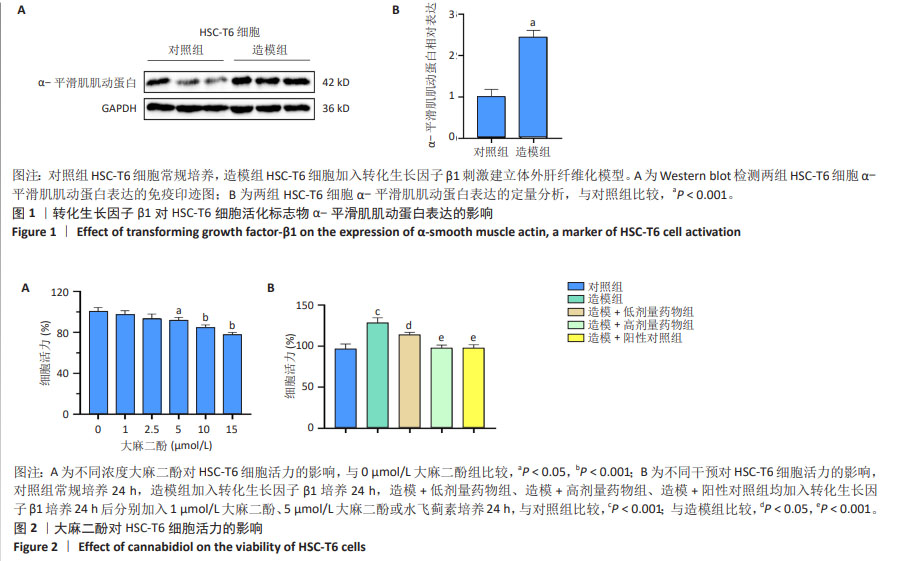
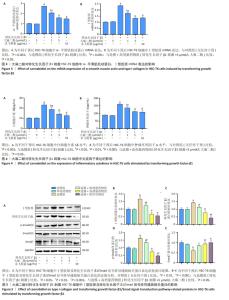
2.1.3 各组HSC-T6细胞中α-平滑肌肌动蛋白、Ⅰ型胶原mRNA表达 与对照组比较,单纯药物组HSC-T6细胞中纤维化因子α-平滑肌肌动蛋白、Ⅰ型胶原mRNA表达无明显变化(P > 0.05),造模组HSC-T6细胞中Ⅰ型胶原与α-平滑肌肌动蛋白mRNA表达显著升高(P < 0.001),说明转化生长因子β1能诱导HSC-T6细胞发生纤维化;与造模组比较,造模+低剂量药物组、造模+高剂量药物组、造模+阳性对照组HSC-T6细胞中α-平滑肌肌动蛋白、Ⅰ型胶原mRNA表达均降低(P < 0.001);与造模+高剂量药物组比较,造模+低剂量药物组HSC-T6细胞中α-平滑肌肌动蛋白、Ⅰ型胶原mRNA表达降低(P < 0.05),造模+阳性对照组HSC-T6细胞中α-平滑肌肌动蛋白、Ⅰ型胶原mRNA表达无明显变化(P > 0.05),见图3。结果表明,大麻二酚对转化生长因子β1诱导的HSC-T6 细胞活化和纤维化基因的表达有抑制作用。 2.1.4 各组HSC-T6细胞中炎症因子表达的影响 与对照组比较,单纯药物组HSC-T6细胞中白细胞介素1β和肿瘤坏死因子α水平无明显变化(P > 0.05),造模组HSC-T6细胞中白细胞介素1β和肿瘤坏死因子α水平显著升高(P < 0.001);与造模组比较,造模+低剂量药物组、造模+高剂量药物组、造模+阳性对照组HSC-T6细胞中白细胞介素1β和肿瘤坏死因子α水平降低(P < 0.05或P < 0.01或P < 0.001);与造模+高剂量药物组比较,造模+低剂量药物组HSC-T6细胞中白细胞介素1β和肿瘤坏死因子α水平升高(P < 0.05),造模+阳性对照组HSC-T6细胞中白细胞介素1β和肿瘤坏死因子α水平无明显变化(P > 0.05),见图4。结果表明,大麻二酚对活化HSC-T6细胞的炎症反应具有抑制作用。 2.1.5 各组HSC-T6细胞中Ⅰ型胶原及转化生长因子β1/Smad信号转导通路相关蛋白的表达 与对照组相比,单纯药物组HSC-T6 细胞中Ⅰ型胶原及转化生长因子β1/Smad信号转导通路相关蛋白表达水平无明显变化(P > 0.05),造模组HSC-T6 细胞中Ⅰ型胶原、转化生长因子β1、p-Smad2/3 蛋白表达显著升高(P < 0.01或P < 0.001),Smad7蛋白表达显著减少(P < 0.001);与造模组比较,造模+低剂量药物组、造模+高剂量药物组、造模+阳性对照组HSC-T6细胞中Ⅰ型胶原、转化生长因子β1、p-Smad2/3 蛋白表达显著降低(P < 0.05或P < 0.01或P < 0.001),Smad7蛋白表达升高(P < 0.05或P < 0.01或P < 0.001);与造模+高剂量药物组比较,造模+低剂量药物组除Smad7外其余蛋白表达有明显变化(P < 0.05),造模+阳性对照组除了Ⅰ型胶原与Smad7外其余蛋白表达有明显变化(P < 0.05),见图5。这些结果表明,大麻二酚能抑制活化HSC-T6细胞中转化生长因子β1/Smad信号转导通路。"
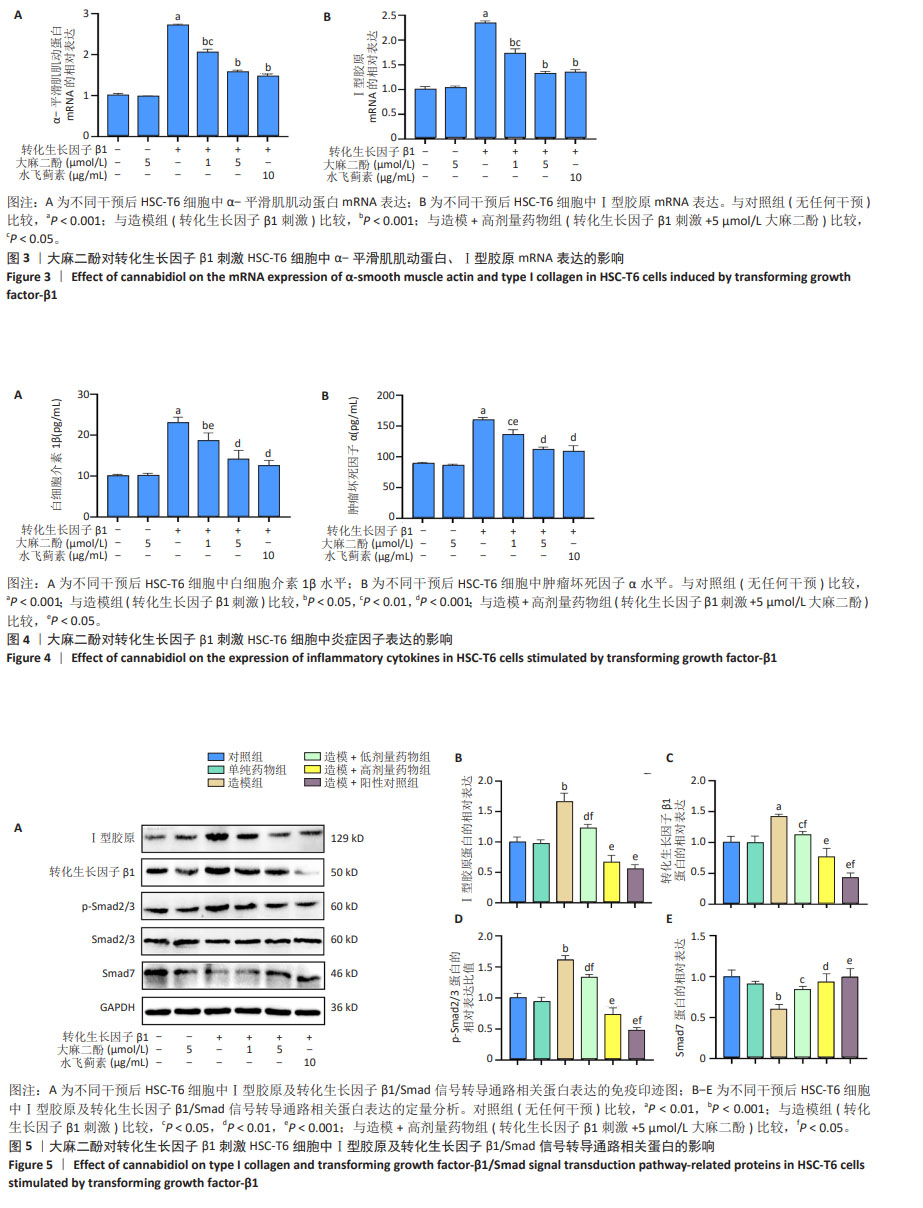
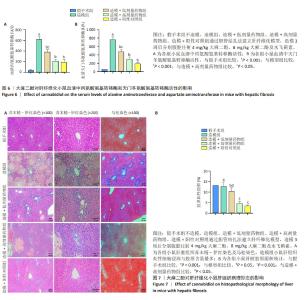
2.2 动物体内实验结果 2.2.1 实验动物数量分析 40只C57BL/6J小鼠全部进入结果分析。 2.2.2 各组小鼠血清中丙氨酸氨基转移酶和天门冬氨酸氨基转移酶活性 与假手术组比较,造模组小鼠血清中丙氨酸氨基转移酶和天门冬氨酸氨基转移酶活性显著升高(P < 0.001),提示小鼠肝细胞发生损伤;与造模组比较,造模+低剂量药物组、造模+高剂量药物组、造模+阳性对照组小鼠血清中丙氨酸氨基转移酶和天门冬氨酸氨基转移酶活性均降低(P < 0.001);与造模+高剂量药物组比较,造模+低剂量药物组小鼠血清中丙氨酸氨基转移酶和天门冬氨酸氨基转移酶活性均升高(P < 0.05),造模+阳性对照组小鼠血清中丙氨酸氨基转移酶和天门冬氨酸氨基转移酶活性无明显改变(P > 0.05),见图6。结果表明,大麻二酚能显著改善肝纤维化小鼠的肝细胞损伤,有一定的肝损伤保护作用。 2.2.3 各组小鼠肝脏病理形态变化 苏木精-伊红染色:假手术组小鼠肝细胞形态完整,肝小叶结构清晰;造模组小鼠肝脏出现大面积坏死,肝小叶结构明显破坏,较多炎症细胞浸润;与造模组比较,造模+低剂量药物组、造模+高剂量药物组、造模+阳性对照组小鼠肝组织坏死程度显著减弱,肝小叶结构可见,炎症细胞浸润减轻,见图7。 马松染色:假手术组小鼠肝脏胶原含量较少;造模组小鼠肝脏胶原呈条索状,胶原含量显著增加;造模+低剂量药物组、造模+高剂量药物组、造模+阳性对照组小鼠肝脏胶原含量少于造模组,见图7。"
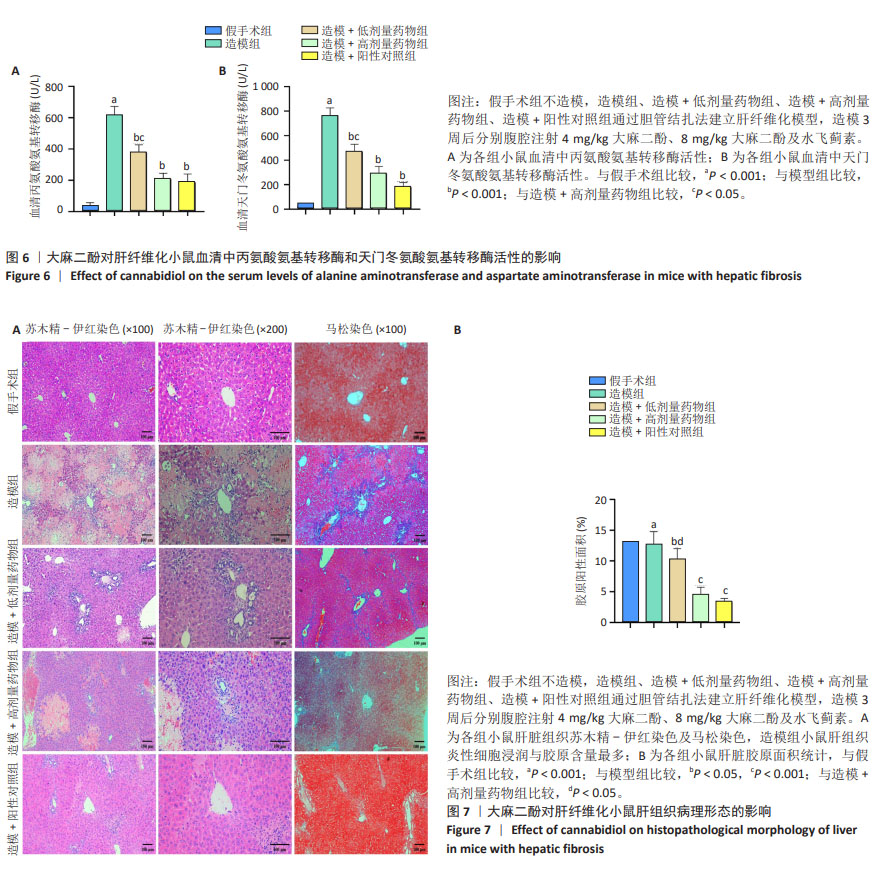
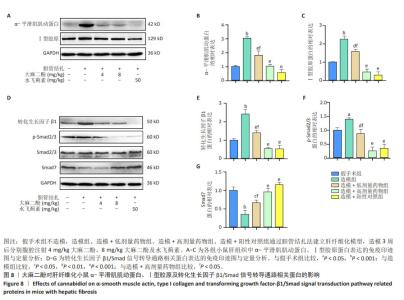
结果表明,大麻二酚能减轻肝纤维化小鼠肝脏组织炎症细胞浸润、减少组织中胶原含量,改善肝纤维化程度。 2.4.4 各组小鼠α-平滑肌肌动蛋白、Ⅰ型胶原及转化生长因子β1/Smad信号转导通路相关蛋白的表达 与假手术组相比,造模组小鼠肝组织中α-平滑肌肌动蛋白、Ⅰ型胶原的蛋白表达显著升高(P < 0.001),转化生长因子β1、p-Smad2/3 的蛋白表达升高(P < 0.001,P < 0.05),Smad7蛋白表达降低(P < 0.001);与造模组比较,造模+低剂量药物组、造模+高剂量药物组、造模+阳性对照组小鼠肝组织中α-平滑肌肌动蛋白、Ⅰ型胶原、转化生长因子β1、p-Smad2/3 蛋白表达均降低(P < 0.01或P < 0.001),Smad7蛋白表达升高(P < 0.05或P < 0.001);与造模+高剂量药物组比较,造模+低剂量药物组α-平滑肌肌动蛋白、Ⅰ型胶原及转化生长因子β1/Smad信号转导通路相关蛋白的表达均有明显变化(P < 0.05),造模+阳性对照组上述指标均无明显变化(P > 0.05),见图8。 结果表明,大麻二酚不仅能抑制胆管结扎致小鼠肝纤维化中转化生长因子β1/Smad信号转导通路的激活,而且能抑制肝星状细胞的活化,从而改善小鼠肝纤维化程度。"
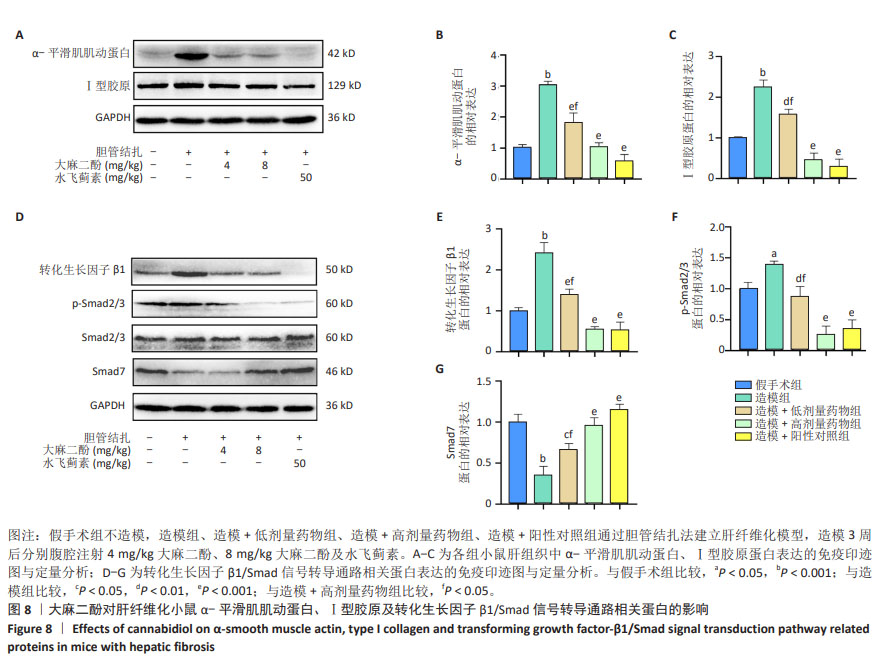
| [1] KISSELEVA T, BRENNER D. Molecular and cellular mechanisms of liver fibrosis and its regression. Nat Rev Gastroenterol Hepatol. 2021; 18(3):151-166. [2] CAI X, WANG J, WANG J, et al. Intercellular crosstalk of hepatic stellate cells in liver fibrosis: New insights into therapy. Pharmacol Res. 2020; 155:104720. [3] LI Y, WANG L, ZHANG Q, et al. Blueberry Juice Attenuates Pulmonary Fibrosis via Blocking the TGF-β1/Smad Signaling Pathway. Front Pharmacol. 2022;13:825915. [4] DEWIDAR B, MEYER C, DOOLEY S, at al. TGF-β in Hepatic Stellate Cell Activation and Liver Fibrogenesis-Updated 2019. Cells. 2019; 8(11):1419. [5] 周林华,陈晓.栀子苷通过TGF-β1/Smad信号通路抑制肝纤维化和肝星状细胞活化[J].生理学报,2022,74(2):217-224. [6] LIU W, WU J, CAO H, et al. Human-Induced Hepatocytes-Derived Extracellular Vesicles Ameliorated Liver Fibrosis in Mice Via Suppression of TGF-β1/Smad Signaling and Activation of Nrf2/HO-1 Signaling. Stem Cells Dev. 2023;32(19-20):638-651. [7] HUANG Y, WAN T, PANG N, et al. Cannabidiol protects livers against nonalcoholic steatohepatitis induced by high-fat high cholesterol diet via regulating NF-κB and NLRP3 inflammasome pathway. J Cell Physiol. 2019;234(11):21224-21234. [8] SURYAVANSHI SV, ZAIACHUK M, PRYIMAK N, et al. Cannabinoids Alleviate the LPS-Induced Cytokine Storm via Attenuating NLRP3 Inflammasome Signaling and TYK2-Mediated STAT3 Signaling Pathways In Vitro. Cells. 2022;11(9):1391. [9] CHU FX, WANG X, LI B, et al. The NLRP3 inflammasome: a vital player in inflammation and mediating the anti-inflammatory effect of CBD. Inflamm Res. 2024;73(2):227-242. [10] 马润,舒远辉,谢娜,等.大麻二酚对小鼠肝纤维化抗氧化作用[J].中国公共卫生,2022,38(2):181-185. [11] 吴雅锋,龙翠珍,舒远辉,等.大麻素受体- 2激动剂AM1241对急性肝损伤小鼠肝组织炎性体NLRP3影响[J].中国公共卫生,2019, 35(5):571-573 [12] 龙翠珍,舒远辉,何萍,等.大麻素受体2激动剂AM1241对TGF-β1诱导的HSC-T6增殖、活化及凋亡的影响[J].天津医药,2020, 48(7): 606-610. [13] XIE N, MA R, WANG L, et al. Cannabidiol regulates the activation of hepatic stellate cells by modulating the NOX4 and NF-κB pathways. Food Chem Toxicol. 2024;186:114517. [14] 杨建华,杨秀娟,赵耀,等.护肝布祖热对CCl4诱导人肝星状细胞LX-2活化的作用及机制研究[J].中药新药与临床药理,2022,33(10): 1315-1321. [15] ZHANG K, ZHANG MX, MENG XX, et al. Targeting GPR65 alleviates hepatic inflammation and fibrosis by suppressing the JNK and NF-κB pathways. Mil Med Res. 2023;10(1):56. [16] BERUMEN J, BAGLIERI J, KISSELEVA T, et al. Liver fibrosis: Pathophysiology and clinical implications. WIREs Mech Dis. 2021; 13(1):e1499. [17] BAI YM, YANG F, LUO P, et al. Single-cell transcriptomic dissection of the cellular and molecular events underlying the triclosan-induced liver fibrosis in mice. Mil Med Res. 2023;10(1):7. [18] 王浩,莫缓椰,孙联康,等.细胞周期蛋白依赖性激酶抑制剂-73对肝纤维化的治疗作用及相关机制研究[J].中华肝胆外科杂志, 2023,29(4):278-284. [19] HAMMERICH L, TACKE F. Hepatic inflammatory responses in liver fibrosis. Nat Rev Gastroenterol Hepatol. 2023;20(10):633-646. [20] RHO H, TERRY AR, CHRONIS C, et al. Hexokinase 2-mediated gene expression via histone lactylation is required for hepatic stellate cell activation and liver fibrosis. Cell Metab. 2023;35(8):1406-1423. [21] SILVESTRI C, PARIS D, MARTELLA A, et al. Two non-psychoactive cannabinoids reduce intracellular lipid levels and inhibit hepatosteatosis. J Hepatol. 2015;62(6):1382-1390. [22] JIANG X, GU Y, HUANG Y, et al. CBD Alleviates Liver Injuries in Alcoholics With High-Fat High-Cholesterol Diet Through Regulating NLRP3 Inflammasome-Pyroptosis Pathway. Front Pharmacol. 2021; 12:724747. [23] YANG L, ROZENFELD R, WU D, et al. Cannabidiol protects liver from binge alcohol-induced steatosis by mechanisms including inhibition of oxidative stress and increase in autophagy. Free Radic Biol Med. 2014;68:260-267. [24] 曹力波,李兵,李佐军,等.水飞蓟素对肝纤维化小鼠的保护作用及机制探讨[J].中国药理学通报,2009,25(6):794-796. [25] BALTA C, HERMAN H, BOLDURA OM, et al. Chrysin attenuates liver fibrosis and hepatic stellate cell activation through TGF-β/Smad signaling pathway. Chem Biol Interact. 2015;240:94-101. [26] YANG CH, TING WJ, SHEN CY, et al. SHSST-cyclodextrin complex inhibits TGF-β/Smad3/CTGF to a greater extent than silymarin in a rat model of carbon tetrachloride-induced liver injury. Mol Med Rep. 2015;12(4):6053-6059. [27] TSUCHIDA T, FRIEDMAN SL. Mechanisms of hepatic stellate cell activation. Nat Rev Gastroenterol Hepatol. 2017;14(7):397-411. [28] 吴朕,马微,臧成昊,等.三七皂苷R1保护四氯化碳诱导肝纤维化模型大鼠的作用[J].中国组织工程研究,2020,24(26):4213-4217. [29] ZHAO YQ, DENG XW, XU GQ, et al. Mechanical homeostasis imbalance in hepatic stellate cells activation and hepatic fibrosis. Front Mol Biosci. 2023;10:1183808. [30] 应勤丽,黄月碧,杨秀翠,等.圣草酚通过抑制TGF-β1/Smad3信号通路改善糖尿病肾病大鼠肾纤维化[J].中国免疫学杂志,2023,39(4): 693-697. [31] 岳杉杉,彭安康,马泽江,等.柚皮素通过调控TGF-β1/smad通路抑制肝纤维化[J].中国药理学通报, 2022,38(2): 248-254. [32] 吉家兴,马俊,李博,等.黄芩素通过Smad信号通路抑制TGF-β1诱导的HSC-T6细胞活化[J].中南医学科杂志,2020,48(3):250-252+256. [33] WU H, CHEN C, ZIANI S, et al. Fibrotic Events in the Progression of Cholestatic Liver Disease. Cells. 2021;10(5):1107. |
| [1] | Yu Shuai, Liu Jiawei, Zhu Bin, Pan Tan, Li Xinglong, Sun Guangfeng, Yu Haiyang, Ding Ya, Wang Hongliang. Hot issues and application prospects of small molecule drugs in treatment of osteoarthritis [J]. Chinese Journal of Tissue Engineering Research, 2025, 29(9): 1913-1922. |
| [2] | Chen Zhenkun, Zhu Shiwei, Xiao Jingnan, Tang Weiping. Mechanism of adipose tissue-derived mesenchymal stem cell-derived exosomes regulating autophagy of hepatic stellate cells [J]. Chinese Journal of Tissue Engineering Research, 2025, 29(25): 5296-5303. |
| [3] | Xu Yan, Wang Xuesong, Zhou Lin, Zhou Xiaolei, Jin Yu, Ye Junsong. Different strategies to enhance mesenchymal stem cells in treatment of liver fibrosis: analysis of efficacy and potential risks [J]. Chinese Journal of Tissue Engineering Research, 2025, 29(23): 5002-5012. |
| [4] | Zhu Wenning, Sun Lili, Peng Lina, Si Juncheng, Zang Wanli, Yin Weidong, Li Mengqi . Mining and verification of inflammation-related genes in skeletal muscle of exhaustive exercise rats undergoing cannabidiol intervention [J]. Chinese Journal of Tissue Engineering Research, 2025, 29(11): 2347-2356. |
| [5] | Liu Ke, Xu Weidong, Zhou Hengyu, Bai Shuo, Zhang Zhen, Ge Ruidong. Role and mechanism of reactive oxygen species in tendinopathy [J]. Chinese Journal of Tissue Engineering Research, 2024, 28(11): 1780-1788. |
| [6] | Xie Na, Ma Run, Wang Lian, Shu Yuanhui, He Ping, Zhou Yan, Xiang Yining, Wang Yuping. Effect of formononetin on glucose oxidase-induced oxidative stress in rat hepatic stellate cells [J]. Chinese Journal of Tissue Engineering Research, 2023, 27(33): 5309-5313. |
| [7] | Tao Bonan, Wang Yonglan, Jiang Lu, Zhang Zongxing, Liu Daozhong, Wan Xing, Huang Debin, Yuan Lin. Rougan Jiangmei Formula medicated serum inhibits activation and autophagy of human hepatic stellate cells [J]. Chinese Journal of Tissue Engineering Research, 2023, 27(33): 5334-5341. |
| [8] | Ye Ting, Li Jing, Xu Lijuan, Ma Li. Skin administration of Wentong Huoxue Cream can relieve inflammation in diabetic peripheral neuropathy rats [J]. Chinese Journal of Tissue Engineering Research, 2022, 26(32): 5091-5096. |
| [9] | Li Xiheng, Li Xinyue, Mao Tianjiao, Yang Wanqi, Tang Liang, Li Jiang. Cannabidiol promotes proliferation and osteogenic differentiation of human periodontal ligament stem cells [J]. Chinese Journal of Tissue Engineering Research, 2022, 26(30): 4867-4872. |
| [10] | Li Xuan, Lu Min, Li Mingxing, Ao Meng, Tang Linmei, Zeng Zhen, Hu Jingwei, Huang Zhiqiang, Xuan Jiqing. In vitro multi-modal imaging of magnetic targeted nanoparticles and their targeting effect on hepatic stellate cells [J]. Chinese Journal of Tissue Engineering Research, 2020, 24(4): 566-571. |
| [11] | Yuan Guoqiang, Qin Yongsheng, Peng Peng. High-intensity interval training for treating pathological cardiac hypertrophy in spontaneously hypertensive rats: effects and mechanisms [J]. Chinese Journal of Tissue Engineering Research, 2020, 24(23): 3708-3715. |
| [12] | Li Hongchao, Wang Xi, Li Li, Li Zhenyu, Zang Zusheng, Zhou Heng, Wang Xiaojin, Chen Chengwei, Cheng Mingliang, Wu Jun, Jin Yinpeng, Fu Qingchun. Therapeutic effect of human adipose stem cells derived exosomes on carbon tetrachloride induced liver fibrosis in rats [J]. Chinese Journal of Tissue Engineering Research, 2020, 24(13): 1996-2004. |
| [13] | Aimaiti Yasen, Jin Xin, Chen Zi-xin, Li De-wei. Intrasplenic co-transplantation of fetal hepatic progenitor cells and transforming growth factor beta 1 induced hepatic stellate cells ameliorates acute liver injury [J]. Chinese Journal of Tissue Engineering Research, 2018, 22(5): 710-716. |
| [14] | Li Cui-fang, Yao Yuan. Mesenchymal stem cells for liver cirrhosis: problems and prospects [J]. Chinese Journal of Tissue Engineering Research, 2015, 19(19): 3102-3106. |
| [15] | Hu Kun-peng, Liu Bo, Yao Zhi-cheng, Lin Ji-zong, Deng Mei-hai, Pan Wei-dong, Lin Nan, Chen Cheng, Xu Rui-yun. Changes in apoptosis-related genes in bone marrow mesenchymal stem cells after cocultured with hepatic stellate cells [J]. Chinese Journal of Tissue Engineering Research, 2014, 18(28): 4444-4449. |
| Viewed | ||||||
|
Full text |
|
|||||
|
Abstract |
|
|||||